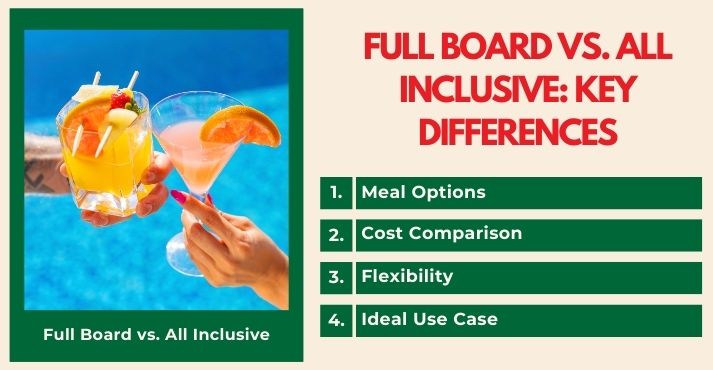When planning a holiday, choosing the right meal plan is more important than it seems. It’s not just about what you eat — it’s about convenience, cost, and how you want to spend your time.
After all, meals can take up a big part of your travel budget, and knowing what’s included ahead of time can make a big difference in how stress-free your trip feels.
Two of the most common options hotels and resorts offer are full board and all-inclusive. Both include breakfast, lunch, and dinner, but the similarities end here. One focuses mainly on meals, while the other often covers extras like drinks, snacks, and on-site entertainment.
It’s a choice that more travelers are thinking carefully about. In fact, 77% of travel advisors say most or some of their clients now choose all-inclusive vacations, mainly because it helps them manage expenses more efficiently and avoid unexpected costs.
In this blog, we’ll discuss the main differences between full board and all-inclusive vacations so you can confidently choose the one that best suits your style of travel and your budget.
What is Full Board?

A full board meal plan typically includes three main meals, breakfast, lunch, and dinner, served at the hotel’s full service restaurant. These meals are usually offered at set times and locations within the property.
However, the plan excludes snacks, drinks (water, soft drinks, and alcohol), and any food or beverages outside the designated mealtimes.
This straightforward and budget-friendly option appeals to travelers who prefer a fixed dining schedule without paying for extras they may not use.
Anything other than the three main meals, like room service, snacks, or beverages, must be purchased separately, often via the hotel’s food ordering system.
Key Features
Full board covers the essentials: three set meals each day. Guests cannot access snacks, in-between drinks, or extras like cocktails and poolside treats. Unlike all-inclusive plans, it’s a no-frills option focused purely on scheduled dining.
This plan suits travelers who enjoy routine and plan to spend much of their day off-property. While convenient, it’s worth remembering that additional food and drinks will incur separate charges.
Ideal For
Full board works well for travelers who want their main meals covered but plan to spend the day out and about.
It’s a practical choice for those exploring local attractions, visiting cultural sites, or enjoying city breaks where lunch or snacks might be grabbed. This plan appeals to guests who value both convenience and flexibility in dining.
Examples
Many budget-friendly and mid-range hotels across Europe and Southeast Asia offer a full board meal plan. Here are a few options:
- Labranda Mares Marmaris – Icmeler, Turkey: A family-friendly resort with buffet-style meals included in a full board package. Ideal for travelers seeking a combination of comfort and affordability.
- Hotel Aqua – Icmeler, Turkey: This beachfront hotel offers full board options with extensive amenities, perfect for those who want set meals without the extras.
- Jupiter Algarve Hotel – Algarve, Portugal: Located in Praia da Rocha, this hotel provides full board holidays, including meals and select drinks. It’s popular for families and travelers looking for a convenient base near the beach.
- Mayang Sari Beach Resort – Bintan, Indonesia: Offers full board with meals at on-site restaurants like Kelong Seafood and Rin Japanese, in tranquil surroundings with traditional chalets.
These hotels provide convenient meal options while allowing guests to explore off-property.
Pros
- Budget Control: Meals are planned and budgeted in advance, reducing unexpected expenses.
- Structured Itinerary: Set meal times can help organize daily activities and excursions.
- Encourages Exploration: With only the main meals covered, many budget-conscious travelers find full board sufficient, especially when planning to discover local restaurants and try regional cuisine beyond the hotel.
Cons
- Additional Costs: Drinks and snacks are not included but can be added if purchased separately.
- Less Flexibility: Set meal times may not align with spontaneous plans or excursions.
- Limited On-Site Amenities: Unlike all-inclusive plans, full board may not cover amenities like free bar service or poolside snacks.
If you like trying local food while traveling, full board provides meals without limiting your options. It’s a good balance for those who want some structure but enjoy dining out.
What is All-Inclusive?

The all-inclusive package is convenient for travelers who want a stress-free vacation experience.
It includes everything from meals and snacks to drinks, both alcoholic and non-alcoholic, and often extends to activities, entertainment, and even extras like airport transfers or spa access, depending on the resort.
With everything paid upfront, you can relax by the pool or enjoy a gourmet dinner without worrying about the bill.
It’s no surprise that this hassle-free approach is becoming more popular. Searches for “all-inclusive” jumped by 60% in 2024, according to Hotels.com, with Gen Z showing a strong preference for this style of travel.
It’s a fully immersive experience that lets you focus on enjoying your trip, not managing your expenses.
Key Features
An all-inclusive meal plan offers many dining options from morning to night. Breakfast, lunch, and dinner are available at multiple on-site restaurants, often featuring buffet spreads, themed nights, and varied menus.
In addition to the main meals, snacks and beverages are available throughout the day, including soft drinks, cocktails, or coffee, ensuring guests can refuel whenever needed.
Unlike other meal plans, the all-inclusive option provides unlimited access to food and drink. Some resorts enhance the experience with specialty dining options like continental food, beachside snacks, and poolside bars, catering to various tastes and dining preferences.
Many resorts include additional perks, such as local excursions and airport transfers, making it an even more seamless vacation experience.
Guests can enjoy everything from on-site activities to spa treatments, all under the same package, and benefit from diverse food service operations ranging from casual snacks to fine dining experiences.
This variety ensures there’s always something to suit every mood and occasion during the stay.
Ideal For
The all-inclusive plan is perfect for those seeking a stress-free vacation with covered meals, drinks, and activities.
It’s ideal for families who want convenience, honeymooners looking for a romantic, hassle-free escape, and anyone wanting to relax without worrying about costs or meal planning.
Examples
Some of the best all-inclusive resorts are known for their luxurious offerings and excellent value for money. Popular destinations include:
- Sandals Resorts – Caribbean: Known for their luxury and exceptional service, Sandals offers a wide range of all-inclusive packages across the Caribbean, with numerous dining options, water sports, and entertainment.
- Club Med – Global (Caribbean, Europe, Asia): A leader in all-inclusive vacations, Club Med’s resorts are ideal for families and adventure lovers, with everything from kids’ clubs to sailing lessons in their packages.
- Iberostar Hotels & Resorts – Spain, Caribbean, Mexico: Famous for their all-inclusive offerings across Spain, the Caribbean, and Mexico, Iberostar resorts are known for their high-quality food service operations and varied entertainment options.
These resorts ensure that guests can indulge in various culinary experiences without worrying about costs while enjoying various activities.
Pros
- Convenience: Everything is included, from meals and drinks to snacks and sometimes even activities, so you don’t have to worry about additional costs or planning.
- Variety: From buffets to à la carte restaurants, you can access a wide range of dining options. Plus, many resorts offer themed nights, making each meal an experience.
- All-In-One Pricing: The upfront price covers almost everything, allowing you to budget with certainty and enjoy your stay without worrying about hidden fees.
- Entertainment and Activities: Many all-inclusive resorts also offer entertainment options like live shows, kids’ clubs, and even excursions, making it easy for guests to stay entertained without leaving the resort.
Cons
- Limited Local Exploration: Some travelers may feel “locked in” to the resort for most of their meals and activities. While the resort offers everything, this might limit the chance to explore local dining and cultural experiences outside the resort.
- Overindulgence: With unlimited food and drinks available, there can be a tendency to overindulge, which may lead to feeling sluggish or overfed by the end of the vacation.
- Not Always Locally Authentic: While you’ll get plenty of variety, the food may be more geared toward international tastes, and you might miss out on authentic local dining experiences.
The all-inclusive plan is perfect for those who value convenience and enjoy having everything taken care of. Just be mindful of the potential trade-offs if you’re looking for more authentic, off-resort dining adventures.
Full Board vs. All Inclusive: Key Differences

When deciding between full board or all-inclusive plans, it helps to know what each offers regarding meals, drinks, flexibility, and overall value. Here’s a simple breakdown of their differences to guide your choice:
[fusion_table fusion_table_type=”1″ fusion_table_rows=”” fusion_table_columns=”” margin_top=”” margin_right=”” margin_bottom=”” margin_left=”” hide_on_mobile=”small-visibility,medium-visibility,large-visibility” class=”” id=”” animation_type=”” animation_direction=”left” animation_speed=”0.3″ animation_offset=””]
| Features | Full Board | All-Inclusive |
|---|---|---|
| Meals Included | Breakfast, lunch, and dinner | All meals (breakfast, lunch, dinner) + snacks |
| Beverages Included | None (drinks outside meals are extra) | Soft drinks, alcoholic beverages, and sometimes specialty cocktails |
| Snacks Included | No | Yes, available throughout the day |
| Activities Included | No | Some activities and entertainment may be included |
| Flexibility | Limited to set meal times | Flexible dining and drinking throughout the day |
| Cost | Generally cheaper | Higher cost but includes more options |
[/fusion_table]
1. Meal Options:
The full board usually includes three main meals daily: breakfast, lunch, and dinner, which are served at the hotel’s restaurant. It does not cover snacks, drinks, or any meals outside the scheduled ones.
If you want something in between, you must pay for it separately. This makes full board a good choice for travelers who are comfortable with a fixed meal schedule and want to keep costs lower.
All-inclusive plans offer more. In addition to the main meals, they include snacks, soft drinks, alcoholic beverages, and sometimes extras like access to specialty restaurants or on-site activities.
Guests can eat and drink throughout the day during the resort’s service hours without extra charges. This makes all-inclusive a flexible and convenient option that adds ease and comfort to your vacation.
2. Cost Comparison:
Full board is usually more affordable than all-inclusive because it covers only the main meals: breakfast, lunch, and dinner.
There’s less variety; anything extra like snacks, drinks, or activities must be paid for separately. If you plan to eat out or don’t need added perks, full board can be a good choice for saving money.
All-inclusive usually costs more upfront, but can be worth it for travelers who want everything taken care of.
It includes meals, drinks, snacks, and sometimes even activities like water sports or spa access. With no surprise charges, guests can relax and enjoy their vacation without worrying about the bill.
3. Flexibility:
All-inclusive plans provide more flexibility than full board. Guests can eat and drink anytime during the hotel’s set meal hours, and often have access to various dining options without additional costs.
This makes it ideal for those who want to enjoy meals and drinks conveniently, without worrying about extra charges.
Full board follows a more rigid meal structure with set breakfast, lunch, and dinner times. This can be restrictive for travelers who prefer to explore local restaurants or wish to eat outside of those scheduled times.
If you enjoy spontaneity and flexibility in your dining, an all-inclusive plan may suit your vacation.
4. Ideal Use Case:
Full board is often the better choice for travelers who prefer a structured vacation and plan to spend significant time exploring local restaurants or off-site attractions. It’s also a good option for those who prefer a more budget-friendly approach while enjoying regular meals.
Couples or solo travelers who want to experience local cuisine can benefit from the flexibility of dining outside the resort.
On the other hand, all-inclusive is great for families, large groups, or anyone seeking convenience and ease. With all the food, drinks, and activities taken care of, guests can focus on relaxing and enjoying their vacation without worrying about additional costs.
This benefits families with children, where meals, snacks, and drinks can quickly add up. All-inclusive resorts are also excellent for those who enjoy various activities and want a stress-free vacation experience.
In short, choosing full board and all-inclusive depends on your preferences and travel style. If you value flexibility and variety, all-inclusive is likely the better choice.
At the same time, full board is great for more budget-conscious travelers who prefer a structured dining experience with the option to explore beyond the hotel. Both options offer different advantages depending on your needs.
Pros and Cons of Full Board vs. All Inclusive
Both full board and all-inclusive plans have advantages, but they cater to different types of travelers. Here’s a closer look at the trade-offs to help you decide which suits your trip best:
Full Board: Pros and Cons
Pros:
Full board gives you a structured dining experience with set meals, making it easier to plan your day. If you prefer exploring local attractions and dining out occasionally, this plan provides flexibility without paying for extras you won’t use.
Cons:
Since drinks, snacks, and extra meals aren’t included, your costs can add up if you stay on-site more often than expected. The limited inclusions may also influence your behavior, as guests may feel less free to indulge, knowing that every extra comes with a price.
All Inclusive: Pros and Cons
Pros:
All-inclusive offers a worry-free experience where everything, from meals to drinks to activities, is covered. You can sample more food and beverages without considering the cost, encouraging guests to try new things and enjoy the resort more fully.
Cons:
While convenient, all-inclusive can be more expensive, especially if you don’t take advantage of all that’s offered. Some travelers also eat or drink more than planned, a common result of menu psychology when everything is already paid for and readily available.
Which Option is Best for You?
Choosing between full board and all-inclusive depends on your travel style, priorities, and how you plan to spend your time.
Full board is a great fit for travelers who want to explore local restaurants, stick to a budget, or enjoy a structured meal plan without paying for extras they may not use. It balances convenience and the freedom to dine outside the hotel.
All-inclusive is perfect for families, larger groups, or anyone looking for a stress-free vacation where everything, from meals and drinks to activities, is covered upfront.
When deciding which plan suits your next trip, consider whether you want the freedom to explore or prefer having everything covered upfront.
Conclusion
Full board offers value and structure, with three meals a day included and room for flexibility in dining and exploration. It’s ideal for travelers who want a set meal schedule while lowering costs.
On the other hand, all-inclusive provides ultimate convenience, covering meals, drinks, snacks, and sometimes activities, making it perfect for those who want to relax and enjoy everything without worrying about extra charges.
Your choice depends on your preferences, vacation type, and budget. Consider whether you value flexibility or convenience and prefer paying upfront or enjoying more spontaneity during your trip.













